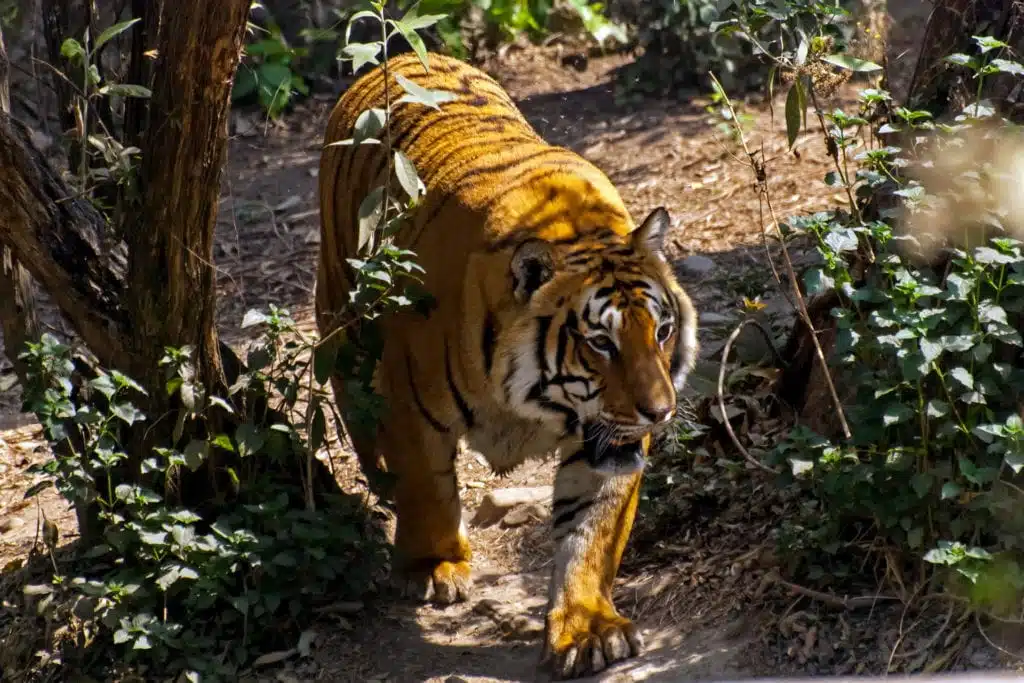THE hunter becomes the hunted on a tiger safari, where our weapons are cameras and smartphones, and the trophies are lasting memories of a truly unique wildlife experience.
Like its fellow “big cat” the lion, the tiger is an apex land predator, but finding this awesome creature in the wild in India is poles apart from an African safari.
And Rothschild Safaris can safely take you into the heart of tiger territory in national parks to see the largest of all living wild cats in its natural habitat.
The Indian or Bengal Tiger is one of only six known subspecies surviving in the wild today and is quite distinctive from the others.
If you’ve ever seen the fictional Shere Khan in Rudyard Kipling ‘s The Jungle Book or Richard Parker in The Life of Pi on the movie screen, you’ll be familiar with the Indian Tiger’s elongated body, short neck and compact head with small muzzle, stout legs and retractile claws.
Adult males, which are larger than the females, can grow to a whopping 290cm in length and weigh a massive 260kg. And just like human fingerprints, all tigers have individual stripe patterns.
The Indian tiger’s reddish-brown to rust-brown coat with black stripes and a white underbelly act as camouflage as it stalks its diverse range of prey in isolated pockets throughout the subcontinent.

Tiger Conservation
But this fierce and mighty beast is in trouble.
At the beginning of the 20th century, the total tiger population in the wild worldwide numbered a possible 100,000. But poachers killing for the skin, bones and other body parts including the penis have conspired with habitat destruction and fragmentation plus ever-dwindling numbers of prey to see a rapid decline in tiger numbers.
India is home to the largest tiger population, but it is still considered endangered, with a total population lying somewhere between what the Save the Tigers Fund believes to be up to 3,750 but what India Today reported on National Endangered Species Day on May 15 to be as little as 2000.
Tigers occur in 19 states in India, with more than 100 found in eight of these.
To ensure the future of this graceful animal, Project Tiger was established in India in 1972 to combat the dangers tigers are always facing in the wild – mostly from severe human pressure in various forms.
Through decades of research on tigers and their prey, the conservation organization is using those scientific guidelines to develop and design protected areas to help the species survive.
As a company we are passionate about tiger conservation and we believe taking you on a unique safari and venturing with our guides into tiger territory on your Indian adventure will have a profound effect on you, too.
And who wouldn’t want to witness the ferocious but disturbingly beautiful Royal Bengal Tiger as close as you dare in the wilds of India?
We know the best places to spot this striped wonder roaming free within their perfect jungle habitats in Bandhavgarh National Park (in the Umaria district of Madhya Pradesh), Ranthambore National Park (in the state of Rajasthan), Kanha Tiger Reserve (also known as Kanha-Kisli National Park, the largest national park of Madhya Pradesh) and Pench National Park of Madhya Pradesh – mentioned in 1894’s The Jungle Book and one of the most popular wildlife reserves in India.
Some of our favorite places to stay on a tiger safari include:
Kanha National Park – Flame of the Forest. Wonderfully isolated this lodge has an ideal location, outstanding hospitality and offers cooking lessons, walks and cycling trips in between game drives.
Kanha National Park – Singinawa Jungle Lodge. Stone cottages or bungalows. Enjoy bush dinners and drinks around the campfire. Indulge in a spa treatment between activities.
Bandhavarh National Park – Samode Safari Lodge. The perfect retreat where in between game drives you can spend time lazing at the poolside and enjoy your favorite cocktail around the campside fire in the evenings.
Panna National Park – Sarai at Toria. Traditionally built cottages with magnificent views over the River Ken. This family run property serves up incredible meals and offer some great insight into local life.
Pench National Park – Jamtara Wilderness Camp. Traditional colonial style camp set in a quiet side of the park. Enjoy the swimming pool before and in between game drives. Opportunity to sleep out on a star bed with nothing but the sounds of the jungle.
Indian Tiger Safari Activities typically include:

Game drives – Your guide on twice-daily game drives is intimately acquainted with these territorial, solitary predators. So you’ll hear fascinating tiger tales – from exactly how they mark out that territory using their scent and scratch marks to why these meat-eaters stalk rather than run down their prey (even though they are very fast over short distances).
Nature walks – follow the trail of the elusive wild tiger into the wilderness with your guide.
Cooking lessons – many of the lodges offer cooking classes in between activities.
Spa treatments – nothing like indulging in a facial or a deep tissue massage after a day out in the bush.
Call our India specialist Viji to learn more about how you can experience these wonderful beasts!
